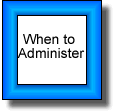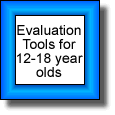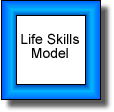 |
|||||||||
 |
|||||||||
 |
|||||||||
 |
|||||||||
 |
|||||||||
Decision Making: Teaching Resources
The Decision Wheel
Materials needed:
· flip chart
· marker
· post-it notes
· copy of Decision Wheel
· paper fasteners to assemble Decision Wheel
· age-appropriate decision page (elementary, middle, high school)
· blank decision page to develop own decision situations
· scissors
· heavy (60 #) paper
Purpose:
· to learn the steps involved in making sound decisions. To practice using decision-making skills
Age:
· elementary to high school (depending on decision situations used)
About Decision-Making
Good decision-making is a skill that you can help youth learn. Youth make decisions everyday. Some of the decisions are easy, such as what to wear, who to sit with on the bus, or what to buy for lunch; however, others are more difficult. More difficult decisions, such as deciding whether to do homework or watch TV, or deciding whether or not to accept a ride from a friend whom has been drinking have more serious consequences than easy decisions.
Not making a decision is really a way of making a decision. Some youth may refuse to make a decision when they don't want responsibility for or have control over the consequences of their decisions. According to a Search Institute survey on developmental assets, 29% of youth surveyed reported that they had planning and decision-making assets in their lives.
Youth can learn the steps and practice the skills necessary to make sound decisions. Below are the steps that the you will use when completing the decision wheel activity.
- Define the problem, issue or situation. Youth should think about the choice or problem, ask others to help them identify their problem and look for information to help them understand the problem.
- Identify alternatives, choices or options. Youth should list or brainstorm all of the possible ways to solve the problem or choices available to them. This step helps them to think before making a choice and identify more than one way to deal with the problem.
- Identify consequences and risks for each choice. Think about the advantages or positive aspects of each possible choice. Then identify the disadvantages or risks involved with making each choice. Encourage youth to think about their family and personal values and how each decision may affect other people.
- Decide on one choice. What is the best alternative? Encourage youth to think about all the information they gathered about each choice and how their decision will affect them and others. Choices may also be based on knowledge, values, religious beliefs and present and future goals.
- Evaluate the decision. Using the steps necessary for sound decision-making will not guarantee that all of the decisions youth make will be the right ones. After an important decision, encourage youth to think about the consequences, use this knowledge to change the decision the next time or be assured that the right decision was made.
Leading the Activity
Make the Decision Wheel.
1. Copy (on heavy paper) enough of the Decision Wheel handouts (A and B) for each youth in your group.
2. Cut out the wheel with the steps to sound decision-making (wheel A) printed on the front. Cut the blank slice of the wheel out.
3. Cut out the wheel with the decision situations (wheel B). Put the paper fastener through the 4-H clover to connect the two parts of the wheel.
Draw a large Decision Wheel on a flip chart or chalkboard, review with the youth. Explain that the Decision Wheel is designed to give them practice using the skills needed for sound decision-making.
Write the first situation from the wheel at the top of the flip chart paper.
Partner youth to discuss the situation. Youth should follow the steps around the wheel to discuss the decision.
Ask each pair to write one solution to the problem or situation per post-it note. Ask them to think about all of the possible options.
Ask each pair to also write the consequences of each solution on a separate post-it note.
Bring the group back together and share the options and the consequences. Put the post-it notes for the choices in the "Identify Alternatives or Choices" slice of the Decision Wheel.
Put the consequence post-it notes on the "Identify Risks and Consequences" slice of the Decision Wheel.
When all of the options and consequences are posted, discuss with the group why they would not choose an option because they don't like the consequences. Remove one option at a time until there is only one option left. That is the choice the group made. Remind youth that this may not be the choice that each individual would have made.
Process what the group learned
Was it more difficult to think of, options with positive or negative consequences?
Why is it important to think of consequences when making a decision?
How can collecting information about a situation help make decision making easier?
Describe a situation where one of your options had both negative and positive consequences.
The next time you make a decision, what will you do differently?
( Process questions adapted from Health: It's Your Choice, Helper's Guide, 4-HCCS Curriculum)
Logging in Decisions
Materials needed:
· Health Decision Log
· pencil
Purpose:
· to be aware of health decisions and their effect on health.
Age:
· upper elementary to high school
About Decision-Making
(see information on p. 2 for background information on the steps to good decision-making.)
Leading the Activity
A. Make enough copies of the Health Decision Log for each youth in your group. Review the steps in sound decision-making, focusing on consequences that may affect their health. Remind them to think of positive and negative consequences on health.
B. Distribute the Health Decision Log. Ask each youth to track any health-related decisions that they make in the next week and record them in the log.
C. At the next meeting, ask participants to share some of their decisions.
Process what the group learned
Were there any decisions that you wished you hadn't made? Why?
Why was it easier to select a choice with a positive consequence?
Did any choices have both positive and negative consequences? What were they?
Health Decision Log
Track your health-related decisions and the effects on your health for one week. Record them in the log below. Share decisions and their effects with your group, a friend or parent.
Day |
Decision |
Effect on Health |
Example |
You went roller blading after school instead of watching your favorite show on TV |
Keeping physically fit |
Day 1 |
|
|
Day 2 |
|
|
Day 3 |
|
|
Day 4 |
|
|
Day 5 |
|
|
Day 6 |
|
|
Day 7 |
|
|
(Adapted from Health: It's Your Choice, Helper's Guide, 4-HCCS Curriculum)
Survival Shopping
Materials needed:
· one large store catalog per group or access to the Internet
· paper and pencils
· play money (optional)
Purpose:
· to explore and discuss decision-making as part of a group
Age:
· upper elementary to high school
About Decision-Making
(see information on p. 2 for background information on the steps to good decision-making.)
Leading the Activity
A. If you have a large group, break into small teams of two to six members (or into as many teams as you have catalogs for).
B. Provide each team with a large catalog from a store that sells a variety of items, or if you have access to the Internet, find a web site that sells a variety of items.
C. Give each team "money" ($200 is a good amount). Tell the group the following story:
"You and your teammates have been selected to spend one year in a space ship traveling to a distant planet and back. You will have one year's supply of food and water on your ship and you each will be issued two sets of clothing. Your team is allotted $200.00 and cannot go over the dollar amount."
D. Give each group paper and pencil to make a list. Set a time limit and at the end of the time limit ask each group to report back with their list. Each group should explain why they chose what they did.
Process what the group learned
Did everyone on your team agree on what to spend your money on?
If everyone didn't agree, how did you finally come to a decision?
Was it difficult to make decisions as a group?
What is the best way to make decisions when in a group? Is this easy or difficult for you?
(Adapted from Team Building Activities for Every Group, Alanna Jones, Rec Room Publishing, Richland, WA, 1999)
Decision road map
Materials needed:
· several road maps
· pencils
· paper
Purpose:
· to learn the importance of asking others for input into important decisions.
Age:
· elementary to high school
About Decision-Making
(see information on p. 2 for background information on the steps to good decision-making.)
Leading the Activity
A. Place three road maps in different parts of the room.
B. Form three teams and have each team choose a home base point on the map and a destination.
C. Encourage teams to find as many different routes as possible to get from their home base (anywhere you select on the map) to their destination.
D. Keep track of how many solutions they develop.
E. Ask youth to discuss why they like or dislike each route. Try to pick the best route.
Process what the group learned
What things happened on your team that helped you find lots of routes?
Was it harder or easier to pick a route as a team than it would be to do by yourself? Is the route you picked better because more people were involved?
When you have to make decisions in your life, in what ways can it help to have input from others?
In addition to getting feedback from others, what are things you do that help you make decisions?
(Adapted from Building Assets Together, Search Institute, 1997)
The Decision Tree
Materials needed:
· flip chart paper
· markers
Purpose:
· to explain the steps used in decision-making to younger youth
Age:
· younger elementary
About Decision-Making
(see information on p. 2 for background information on the steps to good decision-making.)
Leading the Activity
A. Draw a tree on the flip chart.
B. On the base of the trunk, write a decision, situation or problem relevant to younger youth.
C. Ask children to think of solutions and write those on the branches of the tree.
D. After solutions are brainstormed, list consequences for each solution further up the branch.
E. After discussing as a group, mark each consequence as + (positive) or - (negative).
F. Ask the group to decide which solution they think is best and why.
G. At the very top of the tree, write the decision the group decided upon.
The Pennsylvania State University is committed to the policy that all persons shall have equal access to programs, facilities, admission, and employment without regard to personal characteristics not related to ability, performance, or qualifications as determined by University policy or by state or federal authorities. It is the policy of the University to maintain an academic and work environment free of discrimination, including harassment. The Pennsylvania State University prohibits discrimination and harassment against any person because of age, ancestry, color, disability or handicap, national origin, race, religious creed, sex, sexual orientation, or veteran status. Discrimination or harassment against faculty, staff, or students will not be tolerated at The Pennsylvania State University. Direct all inquiries regarding the nondiscrimination policy to the Affirmative Action Director, The Pennsylvania State University, 201 Willard Building, University Park, PA 16802-2801, Tel 814-865-4700/V, 814-863-1150/TTY.
